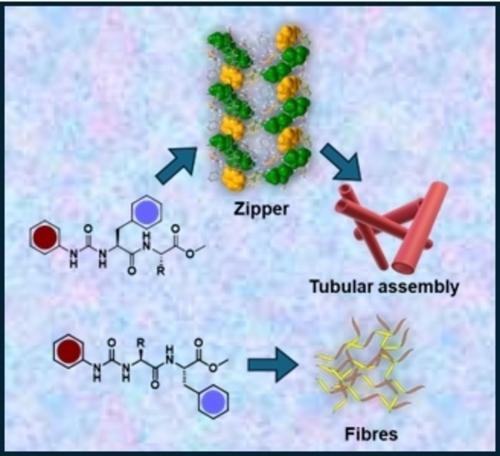设计螺旋状纤维和管材:通过Leu/Ile-Phe拉链自组装混合肽。
IF 2.8
4区 生物学
Q3 BIOCHEMISTRY & MOLECULAR BIOLOGY
引用次数: 0
摘要
在这里,我们介绍了一系列简单的肽,它们表现出多种多样的自组装行为。我们使用脂肪族(Leu/Ile)和芳香族(Phe)氨基酸来描述我们的设计。设计包括位于肽 N 端的亚苯基脲。序列为 Phe-LeuOMe (1) 或 Phe-IleOMe (2) 的脲肽通过拉链排列形成多角形肽管,这一点得到了显微镜和单晶 X 射线衍射研究的支持。Phe远离苯基脲的多肽(3 和 4)呈纤维状组装。所有肽在自组装时都显示出自荧光和红边激发行为。本文章由计算机程序翻译,如有差异,请以英文原文为准。



Designer Helical Fibers and Tubes: Self-assembling Hybrid Peptides via Leu/Ile-Phe Zipper
Here, we present a family of simple peptides that show diverse self-assembling behaviors. We used aliphatic (Leu/Ile) and aromatic (Phe) amino acids to delineate our design. The design consists of phenylene urea at the N-terminus of the peptide. The urea peptides with sequence Phe-LeuOMe (1) or Phe-IleOMe (2) associate to form polygonal peptide tubes via zipper arrangements, supported by microscopic and single crystal X-ray diffraction studies. The peptide with Phe placed away from the phenylene urea (3 and 4), showed fibrous assembly. All the peptides showed autofluorescence and red edge excitation behavior upon self-assembly.
求助全文
通过发布文献求助,成功后即可免费获取论文全文。
去求助
来源期刊

ChemBioChem
生物-生化与分子生物学
CiteScore
6.10
自引率
3.10%
发文量
407
审稿时长
1 months
期刊介绍:
ChemBioChem (Impact Factor 2018: 2.641) publishes important breakthroughs across all areas at the interface of chemistry and biology, including the fields of chemical biology, bioorganic chemistry, bioinorganic chemistry, synthetic biology, biocatalysis, bionanotechnology, and biomaterials. It is published on behalf of Chemistry Europe, an association of 16 European chemical societies, and supported by the Asian Chemical Editorial Society (ACES).
 求助内容:
求助内容: 应助结果提醒方式:
应助结果提醒方式:


